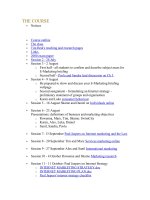Entrepreneurship course outine fall semester
Bạn đang xem bản rút gọn của tài liệu. Xem và tải ngay bản đầy đủ của tài liệu tại đây (93.65 KB, 6 trang )
Course Specification Form
1. Department
Management Sciences
3. Course Code
MG403
3. Course Title
4. Credit Hrs
4 a. Theory
4 b. Lab
Entrepreneurship
5. Contact Hours
5 a.
5 b.
Theory
Lab
3
Bachelor of Business Administration
-
3
N/A
6. Pre-requisites
7. Course Web-Page
8. Course Instructor
MG403
-
Wajeeha Zamir
9. Lab Instructor
N/A
10. Email
11. Textbook(s)
Entrepreneurship – Theory Process Practice (8th edition). Koratko, F.D. Stanford: South
Western - Cengage Learning).
12. Reference Books(s)
Entrepreneurship (8th edition). Hisrich, Peters and Shepherd
13. Other Resources used (e.g. e-learning, field visits, periodicals, software, etc.):
1. Lecture Notes in power point slides and word form.
2. Handouts
3. Recommended Movies and TV shows:
• Pirates of Silicon Valley
• Shark Tanks
• Dragon’s Den
14. Course Objectives (as approved by the dept.)
•
•
•
To understand different methods to assess the attractiveness of business
opportunities.
To understand the key risks and the most effective processes in bringing
different types of products or services to market.
To be able to collect and analyze data to assess the attractiveness of new
business opportunities in regards to the market, the industry, and the team.
15. Course Description/Contents (as approved by the dept.)
At the end of this course, students will be able to:
Develop an idea for a new venture.
Research its potential and understand the risks associated.
Undertake marketing, positioning, and customer development.
Prepare an analysis of the financial requirements and build a financial strategy for
the new venture, including incremental appreciation of the equity base.
5. Plan for the execution and management of all the relevant functional areas of new
venture including operations, supply chain, information systems, and human
1.
2.
3.
4.
1 Abasyn University– Quality Assurance& Accreditation - Course Specification
resources etc.
6. Develop a comprehensive business plan for their venture.
16. Number of CLOs = ##
Course Learning Outcomes (CLO)
CLOs
On successful
completion of the
1
2
course, students
will be able to:
L
1) CLO 1:
p
Description
2) CLO 2:
Description
3) CLO 3:
Description
p
Mapping to PLOs
3
4
5
6
7
8
9
10
11
1
L
1
L
4
p
17. Course Teaching Methods
1) Facilitation
2) Activity based learning
3) Practical work
4) Brainstorming
5) Video Learning
6) Group work /pair programming
7) Presentation and case solving.
18. Grading Scheme
Mid Term : 30%
Assignment : 10%
Quiz
: 5%
Presentation: 10%
Final Term : 50 %
19. Grading Scale
Following is the standard Grading scale applicable to all Abasyn University:
A
A-
B+
B
B-
C+
C
C-
D+
D
F
85-100
80-84
75-79
70-74
65-69
61-64
58-60
55-57
53-54
50-52
Below 50
2 Abasyn University– Quality Assurance & Accreditation - Course Specification
12
Detailed Topics to be covered during the semester
S.#
Topics to be Covered
Assignment/Activities
1
Introduction to Entrepreneurship
1. Concept of entrepreneurship
i.
Definition of Entrepreneurship
ii.
Characteristics of Entrepreneurship
iii.
Benefits of Entrepreneurship
iv.
Drawbacks of Entrepreneurship
v.
Factors affecting Entrepreneurship
2. Functions of entrepreneur.
KP Impact Form filling
Peshawar 2
Drushal
NIC Peshawar
(opportunity discussion)
2
3.
4.
5.
6.
7.
8.
9.
Ten deadly mistakes of Entrepreneurs.
How to avoid failure in Entrepreneurship
Entrepreneur vs Entrepreneurship
Entrepreneur vs Intrapreneur
Types of Entrepreneurs.
Some myths about Entrepreneurship
Entrepreneurial opportunities
Thinking out of the box
3
Practice of Entrepreneurship
Difference between entrepreneurs and normal people.
Entrepreneur Vs Businessman.
Difference between entrepreneur and businessman.
Introduction to online businesses.
Videos:
1.Famous Failures
2.Success stories
4
Understanding the entrepreneurial perspective in individuals
The Entrepreneurial Perspective
•
•
•
Entrepreneurial perspective in organizations – corporate entrepreneurship
Social entrepreneurship and the ethical challenges of entrepreneurship
Steve Job vs Bill Gates.
Understanding strategic issues in business plan development
• Comparative analysis entrepreneurship in other countries
• Strategic Objectives
• Competitor Analysis
3 Abasyn University– Quality Assurance & Accreditation - Course Specification
Google:
1. Top Ten businessman.
2. Top Ten entrepreneurs.
3. Peshawar based entrepreneurs.
5
Creativity and Business Idea
1. Opportunity Identification: The search for New Ideas
2. Sources of new ideas
3. Methods for generating new ideas
4. Entrepreneurial Imagination and Creativity
5. Arenas in Which People Are Creative
Pirates of Silicon Valley
6
Product, branding, Trading, productivity, packaging, efficiency, Investing.
Innovation Vs Invention.
Latest Inventions.
Entrepreneur sees big picture.
Presentation
7
PATHWAYS TO ENTREPRENEURIAL VENTURES
• The Pathways to New Ventures for Entrepreneurs
• Creating New Ventures
•
•
Franchising: The Hybrid
Why New Ventures Fail
Business plan competition
8
Quiz/Test
9
MIDTERM
10
Protecting the idea and other legal issues for the entrepreneur
Legal Challenges for the Entrepreneurial Venture
1.
Intellectual property
2.
Legal issues in setting up the organization
i.
Patents
ii.
Trademarks
iii.
Copyrights
iv.
Trade secrets
v.
Licensing
vi.
Insurance
vii.
Sarbanes Oxley Act
Star Bucks
Activity: Broken Record.
4 Abasyn University– Quality Assurance & Accreditation - Course Specification
11
3.
Identifying Legal Structures for Entrepreneurial Ventures
• Sole Proprietorships
• Partnerships; General, Limited Partner.
• Corporations
Role Play(Buyer and seller)
12
Developing an effective business plan
i.
ii.
iii.
iv.
v.
What is a Business Plan?
Pitfalls to Avoid in Planning
Benefits of a Business Plan
Elements of a Business Plan
Business Cycle
Case Study
13
Marketing challenges for entrepreneurial ventures
i.
The marketing concept for entrepreneurs
ii.
Internet Marketing
iii.
Developing the Marketing Concept
iv.
Developing a Marketing Plan
v.
Marketing Mix
vi.
E-commerce vs M-Commerce
vii.
SWOT Analysis
Ship Activity
14
From the business plan to funding the venture
1.
Sources of capital
i.
Debt or equity financing
ii.
Internal or external funds
iii.
Personal funds commercial bank loans
iv.
The Venture Capital Market
v.
Informal Risk Capital: “Angel” Financing or Angel Investor.
vi.
Net worth
Top 5 Investment companies
Difference between Careen, didi, uber
Investors of Careem
15
STRATEGIC ENTREPRENEURIAL GROWTH
5 Abasyn University– Quality Assurance & Accreditation - Course Specification
1.
2.
3.
4.
5.
6.
7.
The Nature of Strategic Planning in Emerging Firms
The Value of Strategic Planning
Venture Development Stages
Venture Capital.
The Entrepreneurial Company in the Twenty-First Century
Unique Managerial Concerns of Growing Ventures
The International Environment: Global Opportunities
Group Presentation
16
1.
2.
3.
4.
5.
6.
Barter System
Contingency Planning
Collateral Assets
Business Pitch
Crowdfunding; Donation Based, Reward Based, Equity Based.
Insurance and types of Insurance.
Videos:
Famous Brands
Venture Capital
17
Quiz/Test
18
FINAL TERM EXAMINATION
6 Abasyn University– Quality Assurance & Accreditation - Course Specification









